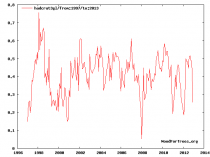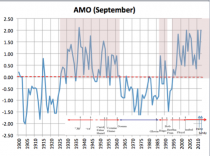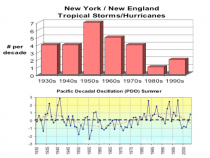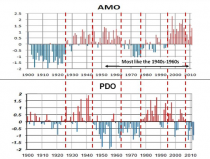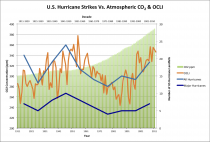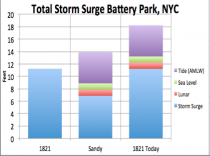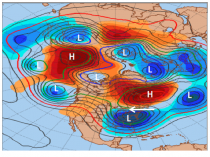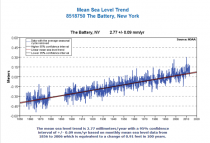n a far-reaching plan that would reshape the coastline of the nation’s largest city, New York City Mayor Michael R. Bloomberg, the modern day King Canute, unveiled a $20-billion proposal Tuesday that he said will protect New Yorkers from disasters brought on by climate change including rising tides. Little Napoleon is delusional.
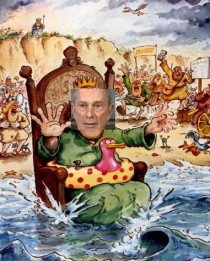
Fox News and the other media carried an AP story about the Bloomberg folly with forecasts that have a 0 (zero) percent chance of verifying.
“The projections paint an unsettling picture of New York’s future: a city where by the 2050s, 800,000 people could be living in a flood zone that would cover a quarter of the land, and there could be as many 90-degree days as is now normal for Birmingham, Ala.
Facing those new projections of the effects of global warming on the nation’s biggest city, Mayor Michael Bloomberg was scheduled to talk Tuesday about what to do about risks that Superstorm Sandy brought into stark relief.
“We have to look ahead and anticipate any and all future threats, not only from hurricanes and other coastal storms but also from droughts, heavy downpours and heat waves—many of which are likely to be longer and more intense in the years to come,” an excerpt from the mayor’s planned speech says.
Two top Bloomberg aides who oversaw the study underlying the speech, Seth Pinsky and Deputy Mayor Caswell Holloway, wouldn’t hint Monday at what the suggestions would be, what they might cost or how they might be financed. Many key decisions likely will come after Bloomberg’s third and final term ends this year.
Bloomberg said last winter the study would examine the pros and cons of building berms, dunes, levees and other coast-protection structures. But he has historically been cool to the idea of massive sea walls—and emphatic about not suggesting that people retreat from coastal communities.
The recommendations will draw from updated predictions from the New York City Panel on Climate Change, a scientists’ (???) group convened by the city.
The average day could be 4 degrees to nearly 7 degrees hotter by mid-century, the panel estimates in data Pinsky and Holloway discussed Monday. A once in a century storm would likely spur a surge 5 or more feet higher than did Sandy, which sent a record 14 foot storm tide gushing into lower Manhattan.
And with local waters a foot to 2 1/2 feet higher than they are today, 8 percent of the city’s coastline could see flooding just from high tides, the group estimates. Most of that coast is in a relatively undeveloped area near a bay.
City Hall, the state government and others have released warnings over the years about climate risks. The city has required some new developments in flood zones to be elevated and has restored wetlands as natural barriers, among other steps.
“Sandy, obviously, increased the urgency of dealing with this and the need to plan and start to take concrete steps,” Holloway said.
The new projections echo 2009 estimates from the climate change panel, but the timeframe for some upper-end possibilities has moved up from the 2080s to mid-century.
“The overall numbers are similar, but we have more compelling evidence now that (a more severe scenario from 2009) is looking like a more realistic possibility now,” due to improved computer models and more evidence that some ice sheets are melting, said Radley Horton, a climate scientist with Columbia University’s Earth Institute and a researcher with the city climate panel.
Scientists have reached a consensus on global warming but still debate how severe the effects will be.”
----------------------
How about zero?
New York temperatures reflect the change in population since 1870 (from less than 1 million to 8.2 million in the five boroughs) but have shown little change for 16 years like the rest of the world. The greatest warming took place during the time the population grew fastest from the 1880s to 1930s. Temperatures and population in recent years have been just like the 1950s.
And Sandy was only a CAT 1 storm. There were 8 storms that made landfall in the northeast from 1938 to 1960, many CAT3. Landfalls of hurricanes along the east coast are favored when the Atlantic is warm (+AMO) and the Pacific cold (-PDO), which is the current state.
If we create an index of the two ocean oscillations (+AMO,-PDO) and call it the Ocean Cycle Landfall Index (OCLI), we see good agreement.
A similar state existed in the early and late 1800s. Landfalling storms on New York CIty occurred in 1815, 1821 and 1893. the 1821 was the worst storm.
Could we see a storm worse than Sandy before the Atlantic cools in 5 to 10 years? YES! And with enhanced blocking in an era of low solar activity, a hit further west on the coast closer to NYC is enhanced just as we saw with Sandy.
Will the Sea level go up a foot by 2020? Doubtful. Recall Hansen in 1988 predicted sea levels would inundate the West Side Highway and be lapping at the Goddard Institute (an important component of the mayor’s scientific advisory panel) Building in 20 years (2008). Sea level has risen 1 inch since 1988. Oh, well.
The Battery , NY Station ID: 8518750
Station Information
Latitude: 40° 42.0′ N Mean Range: 4.53 ft.
Longitude: 74° 0.8′ W Diurnal Range: 5.06 ft.
Established: May 24 1920
NOAA Chart #: 12335
Time Meridian: 75 W
Mean Sea Level Difference:
for 8518750 The Battery, NY
1983-2001 1960-1978 Difference:
5.86 ft.-5.65 ft. = 0.21 ft.
Based on current NOAA data, it will take over 100 years to gain a foot of sea level rise.
See what our friend and associate Anthony Watts found about the sea level story.
And, it really is easy to get freaked out if you don’t pay attention to anything but hype.
Note: this is NOT Professor Scott Mandia in another costume

From the overhyped and virtually overheated UK Met Office meeting yesterday where they tried to explain “The Pause” Telegraph blogger Sean Thomas was there and was able to get first hand reports on what was said. Bishop Hill says: “I think we should be worried.”
First, I asked Stephen Belcher, the head of the Met Office Hadley Centre, whether the recent extended winter was related to global warming.
Shaking his famous “ghost stick”, and fingering his trademark necklace of sharks’ teeth and mammoth bones, the loin-clothed Belcher blew smoke into a conch, and replied,
“Here come de heap big warmy. Bigtime warmy warmy. Is big big hot. Plenty big warm burny hot. Hot! Hot hot! But now not hot. Not hot now. De hot come go, come go. Now Is Coldy Coldy. Is ice. Hot den cold. Frreeeezy ice til hot again. Den de rain. It faaaalllll. Make pasty.”....

Huddersfield, 2017
For a final word, I turned to the greatest climate change scientist of all, Dr David Viner, one-time senior research scientist at the climatic research unit of the University of East Anglia, who predicted in 2000 that, within a few years, winter snowfall would become “a very rare and exciting event”.
However, he was trapped under a glacier in Stockport, so was unable to comment at the time the Telegraph went to press.
More hilarity here.
Meanwhile back in the real world: yawn
By Steve Goreham Originally published in Master Resource.

Climatism, the belief that man-made greenhouse gases are destroying Earth’s climate, is on the wane. Once riding high, the ideology of man-made climate change is losing its influence in governments across the world. Climategate, the release of e-mails from the University of East Anglia, called the science of dangerous warming into question and turned the tide of global opinion.
Background
On November 19, 2009, and unidentified hacker or internal whistle-blower downloaded more than 1,000 documents and e-mails from the Climatic Research Unit (CRU) at East Anglia University in the United Kingdom and posted them on a server in Russia. Within hours, these documents were accessed by websites around the world.
These e-mails were a subset of confidential communications between top climate scientists in the United Kingdom, the United States, and other nations over the last fifteen years. These were the very same scientists that developed the surface temperature data sets, promoted the Mann Hockey Stick Curve, and wrote and edited the core of the Intergovernmental Panel on Climate Change (IPCC) assessment reports.
The incident was branded “Climategate” by British columnist James Delingpole, a label soon adopted by the world. These e-mails provide an insight into practices by researchers that are poor science at best and fraudulent at worst. Bias, manipulation of data, avoidance of freedom of information requests, and efforts to subvert the peer-review process are apparent, all to further the “cause” of man-made global warming. The e-mails were released on the eve of the 2009 United Nations Climate Conference in Copenhagen.
Climatism’s Apex
Just two years earlier, Climatism had swept almost all in its path. The IPCC 2007 Fourth Assessment Report declared that mankind was very likely the cause of global temperature increase. That same year, former Vice President Al Gore and the IPCC shared the Nobel Peace Prize.
In December of 2007, The RENIXX index of the world’s largest renewable energy companies soared to over 1,900. Barack Obama was elected President of the United States in 2008, heralding the rebirth of a more environmentally conscious nation. After securing the majority of primary delegates in June, 2008, candidate Obama declared, “...this was the moment when the rise of the oceans began to slow and our planet began to heal!...”
The year 2009 was set to be a year of triumph for Climatism. The US House of Representatives passed the Waxman-Markey cap-and-trade bill in June and sent it to the US Senate. The Copenhagen Climate Conference in December 2009 was to be the major next step to control global emissions. But the release of the Climategate e-mails just one week prior to the start of the conference shook the science of man-made warming.
Climatism’s Downward Spiral
Today, the man-made global warming movement is headed for a crash. United Nations climate conferences at Cancun (2010), Durban (2011), and Doha (2012) failed to produce an agreement to reduce greenhouse gas emissions. The Kyoto Protocol climate treaty expired at the end of 2012 without a successor agreement. The Waxman-Markey bill was ignored by the US Senate and climate legislation is now a non-starter in the US Congress.
Contrary to climate model predictions, global temperatures have failed to increase for the last fifteen years, confounding the sirens for dangerous climate change. In January of this year, the UK Met Office revised their global temperature forecast downward for the next decade. The early release of a chart from the upcoming Fifth Assessment Report of the IPCC showed that temperatures are running far below IPCC projections. Scientists and leading publications, such as The Economist, now question whether the climate models are too sensitive to greenhouse gas levels.
Renewable energy subsidies have been cut in Germany, Greece, Netherlands, Spain, the UK, and the US. Governments across the world are rethinking their commitment to green energy. The RENIXX index has fallen to 250, down almost 90 percent from the 2007 peak. In April, the European Parliament rejected an effort to prop up the Emissions Trading System. The price of a carbon allowances dropped to under 3 Euros per tonne, down from 20 per tonne in 2011. Climatism has become shaky business.
The Climategate e-mail release has played an important role in shifting global opinions about the theory of man-made warming. Below are some of the most important quotes from Climategate emails. More quotes on climate change, energy, and the environment can be found here.
Emails: On the Theory of Man-Made Warming
“I know there is pressure to present a nice tidy story as regards ‘apparent unprecedented warming in a thousand years or more in the proxy data’ but in reality the situation is no quite so simple.” Dr. Keith Briffa, Climatic Research Unit, disclosed Climategate e-mail, Sep. 22, 1999
“Keith’s [Briffa] series...differs in large part in exactly the opposite direction that Phil’s [Jones] does from ours. This is the problem we all picked up on (everyone in the room at IPCC was in agreement that this was a problem and a potential distraction/detraction from the reasonably consensus viewpoint we’d like to show w/ the Jones et al and Mann et al series).” Dr. Michael Mann, IPCC Lead Author, disclosed Climategate e-mail, Sep. 22, 1999
“...it would be nice to try to ‘contain’ the putative ‘MWP’ [Medieval Warm Period]...” Dr. Michael Mann, IPCC Lead Author, disclosed Climategate e-mail, June 4, 2003
“By the way, when is Tom C [Crowley] going to formally publish his roughly 1500 year reconstruction??? It would help the cause to be able to refer to that reconstruction as confirming Mann and Jones, etc. Dr. Michael Mann, IPCC Lead Author, disclosed Climategate e-mail, Aug. 3, 2004
“I gave up on Judith Curry a while ago. I don’t know what she thinks she’s doing, but it’s not helping the cause, or her professional credibility.” Dr. Michael Mann, IPCC Lead Author, disclosed Climategate e-mail, May 30, 2008
“Well, I have my own article on where the heck is global warming...The fact is that we can’t account for the lack of warming at the moment and it is a travesty that we can’t.”
Dr. Kevin Trenberth, IPCC Lead Author, disclosed Climategate e-mail, Oct. 12, 2009
Emails: Manipulating Temperature Data
“I’ve just completed Mike’s [Mann] Nature trick of adding in the real temps to each series for the last 20 years (i.e. from 1981 onwards) and from 1961 for Keith’s [Briffa] to hide the decline.” Dr. Phil Jones, Director of the Climatic Research Unit, disclosed Climategate e-mail, Nov. 16, 1999
“Also we have applied a completely artificial adjustment to the data after 1960, so they look closer to observed temperatures than the tree-ring data actually were...” Dr. Tim Osborn, Climatic Research Unit, disclosed Climategate e-mail, Dec. 20, 2006
“...If you look at the attached plot you will see that the land also shows the 1940s warming blip (as I’m sure you know). So, if we could reduce the ocean blip by, say 0.15 deg C, then this would be significant for the global mean but we’d still have to explain the land blip...” Dr. Tom Wigley, University Corporation for Atmospheric Research, on adjusting global temperature data, disclosed Climategate e-mail to Phil Jones, Sep. 28, 2008
“We, therefore, do not hold the original raw data but only the value-added (i.e. quality controlled and homogenized) data.” Climatic Research Unit web site, the world’s leading provider of global temperature data, admitting that it can’t produce the original thermometer data, 2011
Emails: Data Suppression and Freedom of Information (FOI) Avoidance
“...We have 25 or so years invested in the work. Why should I make the data available to you, when your aim is to try to find something wrong with it...” Dr. Phil Jones, Director of the Climate Research Unit at East Anglia University, e-mail to Warwick Hughes, 2004
“I’m getting hassled by a couple of people to release the CRU station temperature data. Don’t any of you three tell anybody that the UK has a Freedom of Information Act.”
Dr. Phil Jones, Director of the Climatic Research Unit, disclosed Climategate e-mail, Feb. 21, 2005
“Mike [Mann], can you delete any e-mails you may have had with Keith [Trenberth] re AR4? Keith will do likewise...Can you also e-mail Gene and get him to do the same? I don’t have his e-mail address...We will be getting Caspar to do likewise."Dr. Phil Jones, Director of the Climatic Research Unit, disclosed Climategate e-mail, May 29, 2008
“You might want to check with the IPCC Bureau. I’ve been told that IPCC is above national FOI Acts. One way to cover yourself and all those working in AR5 [the upcoming IPCC Fifth Assessment Report] would be to delete all e-mails at the end of the process. Hard to do, as not everybody will remember it.” Dr. Phil Jones, Director of the Climatic Research Unit, on avoiding Freedom of Information requirements, disclosed Climategate e-mail, May 12, 2009
Emails: Subverting the Peer-Review Literature Process
“...I can’t see either of these papers being in the next IPCC report. Kevin [Trenberth] and I will keep them out somehow, even if we have to redefine what the peer-review literature is!” Phil Jones, Director of the Climatic Research Unit, disclosed Climategate e-mail, July 8, 2004
Steve Goreham is Executive Director of the Climate Science Coalition of America and author of the new book The Mad, Mad, Mad World of Climatism: Mankind and Climate Change Mania.



